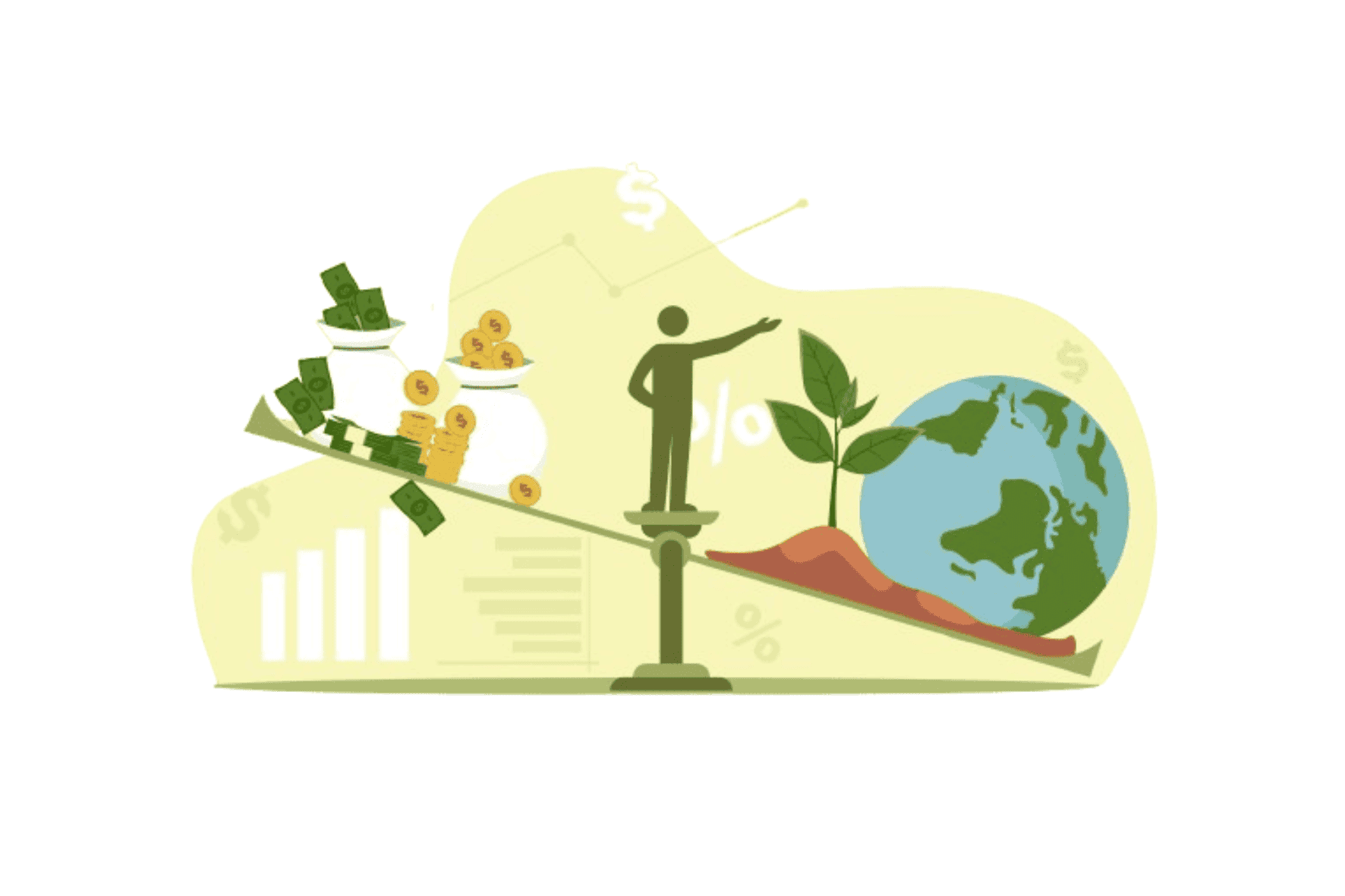The relationship between the environment and the financial market has become increasingly evident, especially in light of growing concerns about climate change, ecosystem degradation, and sustainability. This link is strengthening as companies, governments, and investors recognize that environmental impact can directly affect financial performance, business longevity, and investment opportunities.
1. The Rise of Sustainable Investing
In recent years, the concept of sustainable investing or ESG (Environmental, Social, and Governance) criteria has gained prominence in the financial market. ESG criteria assess a company’s performance not only based on traditional financial metrics but also on environmental, social, and governance factors.
- Environmental: Refers to the impact of the company’s activities on the environment, such as carbon footprint, resource use, and waste management.
- Social: Evaluates how the company treats its employees, communities, and other stakeholders.
- Governance: Analyzes the company’s governance structure, including transparency, corporate ethics, and board diversity.
Pressure for companies to adopt more sustainable practices has been growing, driven by regulators, investors, and consumers. For beginner investors, it is important to understand that companies with good environmental practices tend to perform more resiliently in the long term, avoiding fines, penalties, and reputational damage.
2. Climate Change and Financial Risks
Climate change represents a significant risk to the financial market. The increasing intensity and frequency of extreme weather events, such as hurricanes, floods, and droughts, can disrupt supply chains, damage infrastructure, and increase companies’ operational costs. For sectors like agriculture, energy, and insurance, these impacts can be devastating.
Companies operating in vulnerable regions or relying on scarce natural resources face substantial financial risks. This can directly affect stock value, cash flow, and profitability. Therefore, investors are increasingly considering climate risk when evaluating investment opportunities.
3. Transition to a Low-Carbon Economy
The pressure to reduce greenhouse gas emissions and mitigate climate change impacts has led many countries to adopt stricter policies regarding carbon emissions. The transition to a low-carbon economy involves replacing fossil fuels with renewable energy sources, such as solar and wind, as well as adopting more efficient resource-use technologies.
This transition creates investment opportunities in sectors related to sustainability, such as clean energy, sustainable transportation, and recycling technologies. For beginner investors, investing in companies leading this transition can be a way to position themselves in a growing market.
4. The Role of Environmental Regulations
Stricter environmental regulations also play a key role in the intersection between the environment and the financial market. Governments worldwide are implementing policies to limit pollution, encourage the use of renewable energy, and protect biodiversity. This directly impacts the financial performance of companies operating in sectors that traditionally have a significant environmental impact, such as mining, oil, and gas.
Companies that fail to adapt to these regulations face fines, restrictions, and even the loss of their license to operate. On the other hand, companies that align with new environmental policies may benefit from government incentives and increased demand for sustainable products and services.
5. The Emergence of Green Bonds
Another example of the convergence between the financial market and the environment is the rise of green bonds. These bonds are issued by companies, governments, or financial institutions to finance projects with environmental benefits, such as renewable energy, sustainable infrastructure, and natural resource conservation.
Investing in green bonds allows investors to contribute directly to environmental protection while still earning financial returns. This asset class has attracted both institutional and individual investors, serving as a way to diversify portfolios with a sustainable bias.
6. Environmentally Irresponsible Companies: Risks for Investors
In addition to identifying opportunities, investors should also be aware of the risks associated with companies that have a history of poor environmental practices. Companies that are negligent about their environmental impact are more susceptible to lawsuits, protests, and consumer boycotts.
These problems can lead to significant financial losses, not only in terms of fines but also in loss of market value and reputational damage. For beginner investors, avoiding these companies is crucial to mitigating risks.
7. The Role of Green Fintechs
Green fintechs are emerging as a new trend in the financial sector, focusing on technological solutions that help promote sustainability. These companies use innovations like blockchain, artificial intelligence, and big data to create financial products and services aimed at environmental sustainability.
Examples include investment platforms that facilitate the purchase of shares in sustainable companies, carbon offset services, and crowdfunding solutions for ecological projects. Beginner investors can explore these fintechs to find new ways to invest responsibly.
8. The Impact of the Conscious Consumer
Another factor connecting the environment to the financial market is the growing demand for sustainable products by consumers. Consumers are becoming more informed and demanding about the environmental impact of the products they buy. As a result, companies that adopt responsible environmental practices are more likely to attract and retain customers, which can, in turn, boost their financial performance.
This consumer behavior directly affects the stock value of companies committed to sustainability. Therefore, beginner investors should consider this trend when choosing where to allocate their capital.
9. How Beginner Investors Can Benefit
For beginner investors, understanding the relationship between the environment and the financial market can help make more informed decisions. Some strategies include:
- Choosing ESG investment funds: Investing in funds that follow ESG criteria can provide an accessible way to gain exposure to companies with good environmental practices.
- Diversifying with green bonds: Including green bonds in a portfolio can be a way to diversify with sustainable and low-risk assets.
- Following energy transition trends: Investing in companies leading the transition to a low-carbon economy can generate long-term returns.
10. ESG Index Funds and Sustainable ETFs
One practical and accessible way to invest with a focus on sustainability is through ESG index funds and sustainable ETFs (Exchange-Traded Funds). These financial products aggregate a portfolio of stocks from companies that adhere to strict environmental, social, and governance criteria. The ETF market has grown significantly, with various products focused on sustainability, such as clean energy ETFs, companies promoting good environmental practices, or those with a low carbon footprint.
For beginner investors, sustainable ETFs and ESG index funds offer the advantage of diversification while reducing the risk associated with picking individual stocks. As these funds are passively managed, they often have lower management fees, making them an attractive option for those looking for long-term investments.
11. Transparency and Sustainability Reports
With the increasing focus on environmental issues, more companies are publishing sustainability reports that detail their environmental practices and impact. These reports are a valuable tool for investors who want to better understand how a company is managing its environmental responsibilities.
These documents often include information about carbon footprint, renewable energy use, conservation efforts, and waste management. Companies that are transparent about their environmental performance tend to be more well-regarded in the financial market, as transparency builds investor trust and reduces the risk of negative surprises in the future.
For beginner investors, learning to interpret these reports is a crucial step toward making more informed and responsible investment decisions.
12. Green Financing and Sustainable Private Equity
Beyond green bonds, another important component in the financial market is green financing strategies through private equity funds that invest in companies focused on sustainability. These funds aim to finance emerging businesses developing technologies and solutions aimed at environmental preservation and carbon reduction.
Investors interested in early-stage companies may find sustainable private equity a way to support innovations in the environmental sector while diversifying their portfolios. However, it is essential to remember that private equity involves higher risks compared to more conservative investments, which may not be suitable for all beginner investors.
13. The Risk of Greenwashing
With the growing popularity of sustainable investments, a recurring problem is greenwashing. This term refers to companies that promote practices or products as “environmentally friendly” or “sustainable” without truly implementing significant measures to reduce their environmental impact. Greenwashing can deceive investors, leading them to believe they are making responsible choices when, in fact, they are investing in companies not genuinely committed to sustainability.
Beginner investors should be mindful of this risk and conduct thorough research before making investment decisions. In addition to sustainability reports, it is important to verify a company’s reputation through independent sources, such as third-party analyses, ESG rating agencies, or non-governmental organizations that monitor corporate environmental responsibility.
14. Circular Economy and Investment Opportunities
The concept of the circular economy is another area gaining traction at the intersection of the environment and the financial market. The circular economy promotes the reuse of resources, waste reduction, and increased efficiency in the production and consumption of goods. Companies that adopt business models based on circularity can generate significant cost savings while contributing to environmental preservation.
For investors, companies at the forefront of the circular economy present an interesting investment opportunity. Sectors such as fashion, technology, and food are beginning to integrate circularity principles into their supply chains, opening new doors for sustainable growth.
15. The Future of the Financial Market and the Environment
The future of the financial market is intrinsically linked to the environment. As climate change and other environmental issues become more pressing, the financial market will also be forced to adapt. This includes new regulations requiring carbon emissions reporting, greater transparency about corporate environmental impact, and the creation of new financial products that support green initiatives.
For beginner investors, this means that the field of sustainable investments will continue to grow, offering new opportunities for those who wish to align their environmental values with their investment decisions.
Conclusion: Opportunities and Responsibility
Understanding the relationship between the environment and the financial market offers not only a broader perspective on investments but also an opportunity to contribute to a more sustainable future. The transition to a greener economy is underway, and investors who adopt a proactive and informed approach can benefit from this trend.
Companies that are at the forefront of environmental and sustainability practices are better positioned to face future challenges, and investors who recognize these opportunities can achieve solid returns while helping mitigate environmental impacts. When considering investment options, it’s important to take into account not only the potential for profit but also the impact these investments can have on the planet.
For beginners, exploring sustainable investment principles, understanding the risks and opportunities of greenwashing, and staying alert to innovations in green fintechs and the circular economy are essential steps for navigating this new market environment, where the environment and finance go hand in hand.




